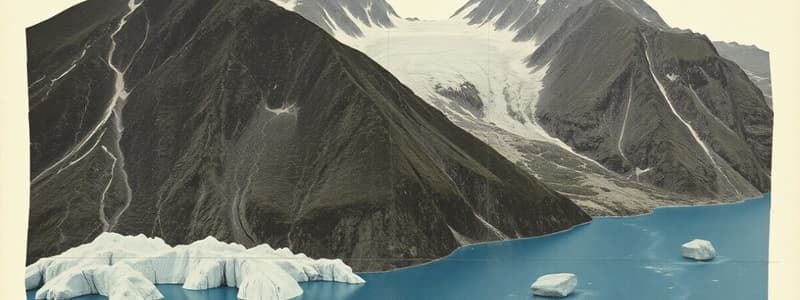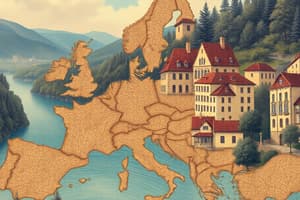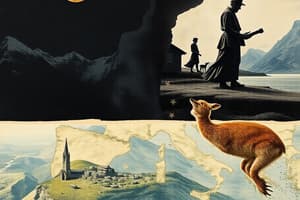Podcast
Questions and Answers
What is the process by which glaciers form and spread called?
What is the process by which glaciers form and spread called?
- Cryogenic Freezing
- Continental Rebound
- Glaciation (correct)
- Fjord Formation
What is a fjord?
What is a fjord?
- A long, steep-sided valley now filled by seawater (correct)
- A type of mountain found in Scandinavia
- A type of glacier
- A geological process that creates lakes
What geological phenomenon results in the rise of land masses previously depressed by ice sheets?
What geological phenomenon results in the rise of land masses previously depressed by ice sheets?
- Erosion
- Lithification
- Continental Rebound (correct)
- Subduction
What form of energy conversion captures heat energy from within the Earth?
What form of energy conversion captures heat energy from within the Earth?
Which climate is characterized by dry conditions, poor soil quality, and extreme cold in the extreme northern parts of Scandinavia and Iceland?
Which climate is characterized by dry conditions, poor soil quality, and extreme cold in the extreme northern parts of Scandinavia and Iceland?
What type of climate covers most of the northern half of Scandinavia?
What type of climate covers most of the northern half of Scandinavia?
Which of the following is a major source of revenue for Finland and Sweden?
Which of the following is a major source of revenue for Finland and Sweden?
Which country generates electricity primarily from renewable wind power?
Which country generates electricity primarily from renewable wind power?
What is the significance of the Mistral wind in southern France?
What is the significance of the Mistral wind in southern France?
What type of climate is predominantly found in much of Northwestern Europe?
What type of climate is predominantly found in much of Northwestern Europe?
Which energy source does the Netherlands rely on the most?
Which energy source does the Netherlands rely on the most?
What event in the 1500s significantly decreased the power of the Roman Catholic Church?
What event in the 1500s significantly decreased the power of the Roman Catholic Church?
Which significant social movement sought to challenge traditional views during the 1700s?
Which significant social movement sought to challenge traditional views during the 1700s?
What was a major outcome of the Treaty of Versailles?
What was a major outcome of the Treaty of Versailles?
What is the role of guest workers in Northwestern Europe?
What is the role of guest workers in Northwestern Europe?
How did the Industrial Revolution affect the workforce in Europe?
How did the Industrial Revolution affect the workforce in Europe?
What is a primary characteristic of the European Union, established in 1992?
What is a primary characteristic of the European Union, established in 1992?
What defines agribusiness in Northwestern Europe?
What defines agribusiness in Northwestern Europe?
During which period did the Viking raids predominantly occur?
During which period did the Viking raids predominantly occur?
What role did the Kalmar Union play in Nordic history?
What role did the Kalmar Union play in Nordic history?
Which of the following statements regarding population patterns in Northern Europe is true?
Which of the following statements regarding population patterns in Northern Europe is true?
What is a defining characteristic of Iceland's population?
What is a defining characteristic of Iceland's population?
What is the main economic significance of the Rhine River?
What is the main economic significance of the Rhine River?
Which of the following describes the Nordic welfare state?
Which of the following describes the Nordic welfare state?
Which factor has contributed to the lower population densities in Northern European countries?
Which factor has contributed to the lower population densities in Northern European countries?
What environmental issue affects the Baltic Sea ecosystem?
What environmental issue affects the Baltic Sea ecosystem?
What percentage of Sweden’s residents live in and around Stockholm?
What percentage of Sweden’s residents live in and around Stockholm?
What is the term used for a low-lying area from which seawater has been drained?
What is the term used for a low-lying area from which seawater has been drained?
Which statement best describes the Protestant religion in Nordic countries?
Which statement best describes the Protestant religion in Nordic countries?
Which of the following describes the impact of acid rain?
Which of the following describes the impact of acid rain?
What characterizes the geography of Northern Europe?
What characterizes the geography of Northern Europe?
What are invasive species primarily recognized for?
What are invasive species primarily recognized for?
What was the effect of industrialization in the 19th century on Nordic societies?
What was the effect of industrialization in the 19th century on Nordic societies?
Flashcards
Mistral Wind
Mistral Wind
A strong, cold northerly wind that originates in the Alps and blows down into southern France.
Foehn Wind
Foehn Wind
A warm, dry wind that blows down the leeward slopes of mountains, often causing snow to melt and avalanches.
Humus
Humus
A rich, dark soil material formed from decaying leaves and other organic matter, making the soil extremely fertile.
Mediterranean Climate
Mediterranean Climate
Signup and view all the flashcards
Crusades
Crusades
Signup and view all the flashcards
Renaissance
Renaissance
Signup and view all the flashcards
Protestant Reformation
Protestant Reformation
Signup and view all the flashcards
Enlightenment
Enlightenment
Signup and view all the flashcards
Industrial Revolution
Industrial Revolution
Signup and view all the flashcards
Guest Worker
Guest Worker
Signup and view all the flashcards
Viking Age
Viking Age
Signup and view all the flashcards
Kalmar Union
Kalmar Union
Signup and view all the flashcards
Continental Society
Continental Society
Signup and view all the flashcards
Parliament
Parliament
Signup and view all the flashcards
Sami
Sami
Signup and view all the flashcards
Ethnic Homogenous
Ethnic Homogenous
Signup and view all the flashcards
Welfare State
Welfare State
Signup and view all the flashcards
Nordic Model
Nordic Model
Signup and view all the flashcards
Water Stratification
Water Stratification
Signup and view all the flashcards
Invasive Species
Invasive Species
Signup and view all the flashcards
Loess
Loess
Signup and view all the flashcards
Dike
Dike
Signup and view all the flashcards
Polder
Polder
Signup and view all the flashcards
Entrepôt
Entrepôt
Signup and view all the flashcards
Break-of-Bulk
Break-of-Bulk
Signup and view all the flashcards
What is a Fjord?
What is a Fjord?
Signup and view all the flashcards
What is Continental Rebound?
What is Continental Rebound?
Signup and view all the flashcards
What is Geothermal Energy?
What is Geothermal Energy?
Signup and view all the flashcards
What is a Geyser?
What is a Geyser?
Signup and view all the flashcards
What is Peat?
What is Peat?
Signup and view all the flashcards
What is the North Atlantic Current?
What is the North Atlantic Current?
Signup and view all the flashcards
What is Arctic Tundra?
What is Arctic Tundra?
Signup and view all the flashcards
What are the main climate influences of Northern Europe?
What are the main climate influences of Northern Europe?
Signup and view all the flashcards
Study Notes
Physical Geography of Europe
- Europe is a large peninsula composed of numerous smaller peninsulas.
- Northern Europe is shaped by glaciers, plate tectonics, and a cold climate.
- Glaciation is the process of glacier formation and spread.
- Fjords are long, steep-sided valleys filled with seawater.
- Continental Rebound is the rise of landmasses depressed by ancient ice sheets.
- Norway and northern Sweden are primarily mountainous, with many fjords along the Atlantic coast.
- Finland is relatively flat, with a few hills and mountains, and numerous offshore islands.
- Iceland is an island in the North Atlantic, characterized by 200 volcanoes and frequent earthquakes.
- Geothermal energy is derived from Earth's internal heat.
- Hot springs and geysers are common geological features.
- Glaciers have shaped the Scandinavian Peninsula, creating many lakes, waterfalls, and swift-moving rivers, hindering city connections.
- Latitude, mountain barriers, wind patterns, and distance from large bodies of water significantly influence European climate.
- The North Atlantic Current (Gulf Stream) moderates temperatures at higher latitudes.
- Artic tundra exists in Scandinavia and Iceland, with harsh conditions including poor soil and limited vegetation. Animals adapt via migration during the winter.
- Subarctic and marine west coast climates dominate parts of Scandinavia.
- Southern Scandinavia and Finland have a humid continental climate.
- Finland has significant peat deposits (vegetation in swamps) used as fuel.
- Natural resources include iron ore, nickel, zinc, copper, and forest products.
- Rivers are used for hydroelectric power generation.
- Norway and Denmark have oil and natural gas reserves in the North Sea.
- Denmark also generates electricity from renewable wind power.
Human Geography of Northern Europe
- Northern Europe has been shaped by migration, invasions, and trade over centuries.
- Nordic countries exhibit similar cultural traits.
- The Viking Age (793-1050) saw Scandinavian raids on European coastal areas.
- Norway's geography (coasts, mountains, fjords) fostered natural boundaries.
- The Kalmar Union (1300s) united Denmark, Norway (Iceland), and Sweden (Finland).
- Trade connected the Nordic countries to mainland Europe, leading to greater continental influences.
- Industrialization in the 19th century spurred population growth and new social classes.
- Democracy and self-governance became prominent features in these countries, with elected parliaments.
- Population patterns are influenced by migration and varying ethnic groups.
- Sami people are native to northern Norway, Sweden, and Finland.
- Migration to Northern Europe from other regions, including post-war Africa, added diversity.
- Norway, while not part of the EU, attracts international workers for its petroleum industry.
- Population distribution in Norway is concentrated along coastlines.
- Low birth rates and increasing life expectancy are increasing the proportion of older people in populations of Denmark and Finland.
- Finland's population is largely urban, concentrated near the southern coast.
- Iceland has a fairly homogenous population; commercial fishing and agriculture are crucial.
- Northern European countries have lower population densities than the rest of Europe due to climate and geography.
- Protestantism is the dominant religion, with varying levels of religious practice.
- Universal schooling, robust social welfare policies (including maternity and paternity leave, and daycare), and high cultural expression are common.
- Small, open economies with foreign trade significant for Northern Europe.
- Commercial fishing is crucial in Iceland and Norway. Forestry, manufacturing, agriculture, and service industries are other important economic sectors in the Nordic countries.
- The "Nordic Model" describes a mixed economy emphasizing labor participation, gender equality, and fiscal expansion.
People and Their Environment
- Overfishing endangers key commercial species.
- Water stratification (water layer immobility) in the Baltic Sea limits plankton production, impacting species.
- Pollution from runoff poses environmental risks to the Baltic Sea Ecosystem.
- Invasive species threaten natural ecosystems.
- Deforestation from logging and agriculture has impacted European forests.
- Freshwater tidal marshes are important habitats for wildlife, but destruction of wetlands for other purposes is a threat.
- Hydroelectric projects change river flows.
- Acid rain is a major environmental concern associated with air pollution.
- Environmental planning and management aims for sustainability.
- Ecotourism is increasingly important.
Northwestern Europe
- Northwestern Europe includes the Northern European Plain, fertile and rich with rivers. Loess is a significant topsoil type.
- The Alps, formed by folding of the Earth's crust and shaped by glaciation, are a mountain range. Mont Blanc is the highest peak.
- The Central Uplands consist of low rounded mountains, hills, high plateaus, and scattered forests rich in natural resources.
- The British Isles (Great Britain and Ireland) feature a rugged coastline with mountains and valleys in the north and west, and low hills and plains in the south.
- Northwestern Europe's proximity to the coast promotes river use for transportation, trade, and recreation.
- Lakes around the Alps offer water power for industry, transportation, and tourism.
- The Netherlands has significant land below sea level, requiring dikes and polders (drained lands).
- Major rivers like the Thames, Rhine, and Seine are crucial for transportation and trade, as is the Danube.
- The North Atlantic Current and prevailing westerlies bring warm air to much of Western Europe.
- Regional winds like the Mistral and Foehn can bring either cold air or result in snowmelt and avalanches impacting southern France.
- Northwestern Europe generally has a marine west coast climate.
- Coal and iron ore deposits, along with North Sea oil and natural gas, support industry in Western Europe.
- France highly relies on nuclear energy for electricity.
- Netherlands utilizes natural gas, with some wind power use.
- Switzerland and Austria rely on renewable sources (hydroelectric and timber).
- Peat is used as fuel, particularly in rural areas.
- Germany imports much of its energy.
Human Geography of Northwestern Europe
- Northwestern Europe was significantly influenced by the Roman Empire.
- Christianity became the official religion in the 4th century AD.
- The Crusades opened trade routes to the eastern Mediterranean and promoted cultural exchange.
- The Renaissance, Protestant Reformation, and Enlightenment periods fostered changes in arts, politics, culture, and religion.
- Industrial Revolution marked a major shift with factories, urbanization, and the emergence of new social concerns.
- Communism emerged as a social and political ideology.
- World Wars and the Cold War significantly shaped the region's history and geopolitical alliances.
- Devolution, or delegation of self-rule, is a trend.
- Population density in Northwestern Europe is high, and guest workers are common.
- Low birth rates and longer lifespans result in aging populations and reduced population growth in some countries.
- Multiple official languages in different countries are common.
- Christianity (primarily Roman Catholic and Protestant branches) is the dominant religion.
- Education, healthcare, and social support systems are crucial aspects of modern societies.
- Important contributions to literature, architecture, music, and the visual arts have been made.
- Industrialization fostered contributions to modern industry and engineering processes.
- Service industries (banking, insurance, tourism) are prominent.
- Efficient transportation and communication links integrate the region and connect it to the rest of the world.
- Agribusiness plays a significant role in the agricultural sector.
- The European Union has promoted economic integration and competitiveness.
Studying That Suits You
Use AI to generate personalized quizzes and flashcards to suit your learning preferences.





